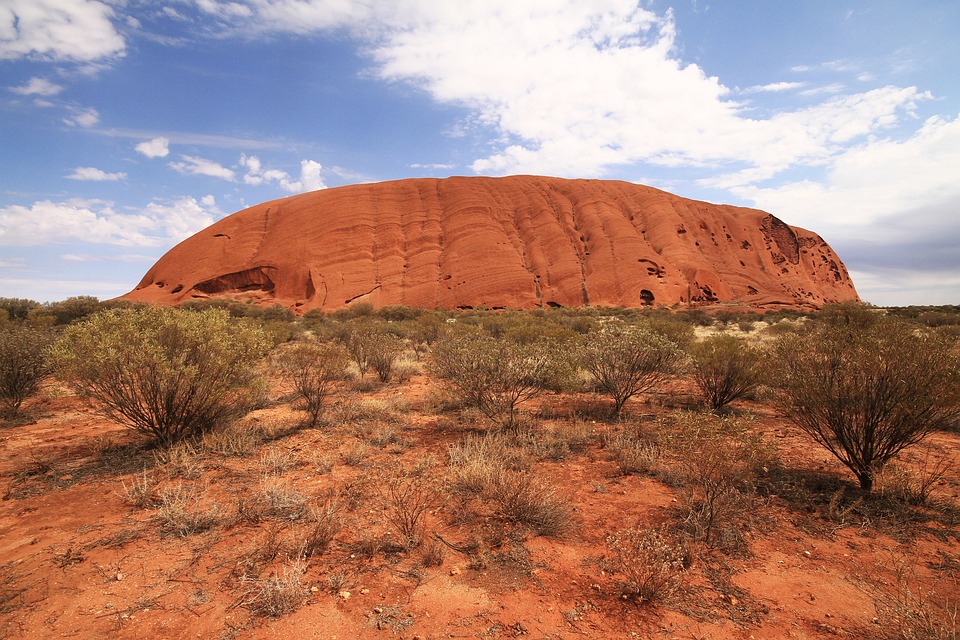▌Ayers Rock has a life of its own beyond the quintessential picture postcards. It indeed is a huge piece of rock begs many questions in the mind of the inquisitive tourist. Combining mystique, beauty and adventure, Ayers Rock is considered a must-see for people visiting this part of the world.

Ayers Rock stands as a challenge to those that view it – its imposing, and it challenges all with questions. What is this chunk of rock doing here? Is it of terrestrial origin? What is it made of? The huge prospect of the mass of rock confounds logic, much like the rock-face in the Hollywood movie Mission to Mars that raised a thousand questions.
It not without justification for the local aborigines, who call this rock Uluru, probably a family name, is worshipped as a sacred place. Like Benares or Parthenon, it is a place or worship to some, and a venue of tourist wonderment for others.
Situated in Uluru-Kata Tjuta National Park, it is virtually in the middle of nowhere, but it draws tourists year round from throughout Australia and the world. Temperatures during summer months can be uncomfortable, and it is always advisable to wear clothes in accordance with weather. At a height of around 350 meters above ground, it is 8 kilometers around. Mistakenly called a monolith, it is part of a much larger underground structure which includes nearby mountains like Mount Connor and the Kata Tjuta, or Mount Olga. Largely a limestone structure, it affords varied surfaces, from long clefts on the surface, perforations and smooth façade.
Discovered in 1872 by explorer Ernest Giles, he described it as the ‘remarkable pebble’, an apt name for the smooth megalith named Ayers Rock after the Chief Secretary of South Australia, Sir Henry Ayers. The rock is famous for changing colors. Not only does it seem to change color from season to season, but even during the day as it captures sunlight from differing angles. The surface feldspar reflects a red light during sunsets and sunrise. A rare rainfall brings out a rush of black algae on its surface, giving it a silver-grey color.
The whole area including and around Ayers Rock is filled with cultural and spiritual artifacts of the local aborigines. The rock is said to house dozens of ancestral ‘beings’ whose abodes are decorated with venerated artwork. The rock forms part of a religious myth that tries to explain the birth of time. It is not surprising, therefore, that many of the aborigines are offended at the tourist intrusion of their ancient land which is held sacred by them.
While climbing Ayers Rock remains a favorite pastime of many sturdy tourists, the aborigines dissuade climbers, in essence. The Cultural Center located in Uluru-Kata Tjuta National Park is a veritable treasure trove of local culture and artifacts and is a center of education on the local culture. The photo collages, history panels, sound samples, interactive audio-visual productions and live interaction with the Ananga people brings about a great understanding of what Uluru has come to mean for them.
However climbing the Ayers Rock is considered a ‘done’ thing by most tourists, much like taking a snorkel dive in the Great Barrier Reef. But tackling the Rock can be a bit of a challenge to all but the fit trekkers. There are many routes that one can take depending upon how comfortable you are with each. It is generally advised that starting trekkers should take the easier routes lined with railings and notices. You can also go with local guides who take you through easier routes providing you with running commentary on significant places. Many people like traveling in groups which is, in fact, a safer option. Of course, it is mandatory that you are properly dressed, have the requisite gear and take lots of water.
Very near to the Uluru are The Olgas, literally meaning ‘little heads’, another group of peculiar rock formations that attract a lot of tourists. A little more distant (100 km) is the much larger Mount Conner, located southeast of Lake Amadeus.
Ayers Rock has fascinated people for as slong as we can remember. It has been a venue of religious veneration and mystique, and now it is an object of public fascination. A symbol of the elemental Australia, Ayers Rock is a must see for all who visit the Northern Territory in this part of the world.
Disclaimer
We take no responsibility for inaccuracy or omissions in the information provided, which is not intended as specific advice. Before relying on the material, you should obtain appropriate professional advice relevant to your individual circumstances to evaluate accuracy, currency, completeness and relevance of the information to your specific needs.
source:LeGuide


























![Le chocolatier suisse Läderach développe une histoire d’amour avec la Chine [ INTERVIEW ]](https://www.afrique-54.com/wp-content/uploads/2023/12/Johannes-Laderach-et-chocolat-e1702548585357-218x150.jpg)











